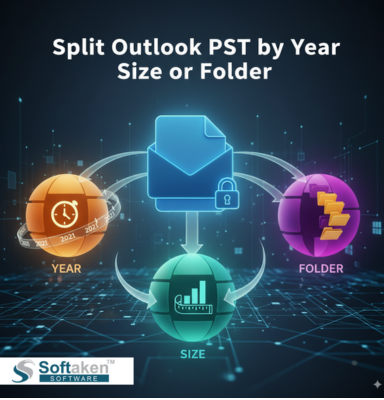Managing a large Outlook data file might get difficult over time. When the PST file exceeds a safe size, Outlook can slow down & show errors or even become corrupt. Many users seek techniques to split Outlook PST into more manageable pieces to keep email data organized and secure. Splitting a PST file results in faster search results, quicker backups and smoother Outlook performance.
This guide explains why splitting is necessary and provides instructions on how to divide an Outlook PST file by year, size or folder. Both manual and automatic options are explored & allowing you to select the best option for your needs.
Why You Could Want to Split Outlook PST
Outlook saves emails, contacts, calendars and other data in a single PST file. As you continue to receive email attachments and meeting invitations & this file grows in size. Although Outlook versions 20 GB and 50 GB are the size limits for older and newer versions, respectively, performance problems can still happen long before these limits are reached.
When the PST file grows too large & you could face issues such as
- Slow start up and reaction time when opening emails.
- Messages such as Outlook Data File Has Reached Its Maximum Size
- Risk of data corruption, which could result in the loss of key emails
Splitting the PST file into smaller portions eliminates these dangers and makes Outlook easier to manage.
The Manual Methods to Split Outlook PST
Microsoft Outlook does not provide a direct option to split a PST file automatically & but you can do the same thing with a few built in capabilities. Here are some useful manual approaches.
Archives by Year
Archiving generates a fresh PST file with data filtered by date
- Open Outlook and navigate to the File menu
- Select Tools followed by Clean Up Old Items or Archive
- Select the folder you want to archive such as Inbox or Sent items
- Choose a date, for example & things older than December 31, 2023
- Set a location for the new PST file
This strategy is useful when you wish to divide Outlook PST by year and keep older emails separate.
Export Selected Folders
If you want to separate by folder, you can export individual folders to a new PST file.
- Go to File, then Open and Export and finally Import Export
- Select Export to a file then Outlook Data File PST
- Choose the folders you want to export such as Sent Items or Projects
- Save the exported data as a new PST file
You can repeat this step for each folder to generate many smaller files
Generate Multiple New PST Files and Transfer Data
Another option is to create numerous blank PST files and manually relocate emails
- To create a new PST, go to the File menu & then Account Settings, Data Files and then Add
- Drag and drop emails or folders from the original PST into the new file
This allows you to limit the size of each file & but it takes time and careful planning
Limitations of Manual Methods
While these manual methods are free and included in Outlook, there are some limitations.
- They are time consuming when the PST is large.
- You have to repeat the procedure for each folder or year you wish to separate.
- If you are not careful, you risk missing emails or moving incorrect data.
Users who manage large amounts of email or need to split Outlook PST regularly would benefit from an automated tool.
Automated Method to Split Outlook PST by Year Size or Folder
An automated method streamlines the work while saving time. A special software that can swiftly split Outlook PST by year, folder size, or select date ranges without erasing data can be used. The Softaken Split PST Tool is a professional solution that can be utilized to manage large PST files and divide them into smaller files based on user defined features.
It’s a pretty easy method. Select the appropriate option to split by year, size or folder after selecting the original PST file. The application will produce several PST files based on your selections & preserving email attachments and features. The procedure is safer, faster and appropriate for both novices and experts
Tips to Handle Outlook Data After Splitting
- Maintain a neat folder hierarchy so that you know which PST file is for which year or project.
- Save the new files in a safe place and make regular backups.
- To maintain performance in Outlook & avoid opening too many PST files at once.
- If you frequently receive large attachments, consider saving them outside of Outlook to reduce file size.
Conclusion
Splitting a large PST file is necessary for keeping Outlook operating at its best and preserving your email record. How to split Outlook PST files by year, size or folder assures mailbox organization, speeds up search and prevents data corruption. Compared to manual methods like archiving, exporting and creating fresh PST files, automated software offers a faster, more secure and more effective way for managing large amounts of data. This is especially true for tiny mailboxes.
In addition to providing you with a stable and seamless Outlook experience, these tips will help you keep your email data organized and safe. Also, you have to create a clear system of organizing and perform regular backups.
